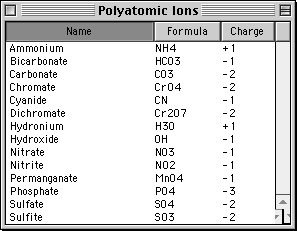So far we have talked about molecular compounds. Ionic compounds are another major class of compounds. They are made up of ions, which are atoms or groups of atoms that bear a positive or negative charge. Many familiar compounds are composed of ions. Table salt (NaCL) and lime (CaO) are just two examples. In order to recognize ionic compounds and to easily write formulas for these compounds, it is important to know the formulas and charges of common ions. You also need to know the names of ions and be able to name the compounds they form. Unfortunately, this is something that must be memorized. Ions are composed of two different types.
Cations are atoms that lose an electron (or two, etc.) Losing an electron give a positive charge so all cations have a positive charge. Some examples are Li+ and Ca +2. Elements on the left side of the periodic table typically are cations. The left two columns are the most common.
Anions generally have a negative charge due to the gaining of one or more electrons. An example is O -2.
These ions can be monatomic (single atoms) or polyatomic (two or more atoms). The following are common polyatomic ions that should be memorized:
For Parents:
The density experiment is this week and before we begin to learn what different materials' densities are, we will be watching this fun video:
Have a great week and don't forget, Density = mass/volume!

No comments:
Post a Comment